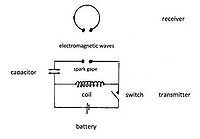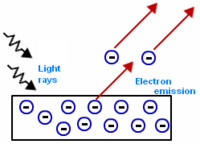Heinrich Hertz
The renowned scientist Heinrich Hertz was the first physicist to prove the existence of electromagnetic waves which was hypothesized in James Maxwell's theory of electromagnetism.

Personal Life
German physicist Heinrich Rudolf Hertz was born on February 22, 1857 into a prosperous and cultured Hanseatic (hierarchy group that constituted the ruling class of Hamburg) family. His father, Gustav Hertz, was a lawyer and later a senator, his mother, Anna Elisabeth Pfefferkorn, was the daughter of a physician, and Heinrich Hertz was the oldest of five children. Both parents were Lutherans but they were more interested in Hertz's education rather than his religious advancement. From the beginning of his education, Hertz was always at the top of his class. He had an uncommon gift for modern and ancient languages; he excelled in Greek at school while taking private lessons in Arabic at the same time. Hertz also had extraordinary aptitudes for mathematics and the sciences. Hertz was homeschooled for a little while before deciding to return to school to prepare him for exams that would admit him to a university. After being an architect's apprentice, completing his army service, and choosing to major in engineering, Hertz finally decided that he wanted to become a physicist. He enrolled in the University of Munich before moving to the University of Berlin to pursue his higher education in physics under Hermann von Helmholtz. In 1880, Hertz received a Ph.D. magna cum laude from the University of Berlin. He then went on to become a professor at the University of Karlsruhe in 1885 and married Elisabeth Doll, the daughter of a lecturer in geometry at Karlsruhe. They had two daughters, Johanna (1887) and Mathilde (1891), who later became a notable biologist. It was during this time that Hertz conducted his prominent research into electromagnetic waves. He also worked on theoretical mechanics and wrote a book. In 1892, Hertz suffered the first signs of serious health problems. He died of granulomatosis with polyangiitis on January 1, 1894 at the age of 36. His book on theoretical mechanics Die Prinzipien der Mechanik was published after his death.
Discovery of Radio Waves
James Maxwell's Theory
In 1865, Scottish scientist James Maxwell came up with the theory of electromagnetism, which is one of the main pillars of modern theoretical physics. In his theory, Maxwell predicted that electromagnetic waves do exist. By constructing an oscillating electrical circuit, he showed that electromagnetic waves could move through empty space. He proposed that light (and other forms of radiant energy) is an electromagnetic disturbance in the form of waves.
The Beginning
While Hertz was at Karlsruhe, he decided that the focus of his research should be on proving Maxwell's theory of electromagnetic radiation. One day, Hertz was showing his students electric sparks. He performed a series of experiments that generated sparks in various ways. Through these experiments, Hertz discovered that the sparks were producing a regular electrical vibration within the electric wires they jumped between. According to Hertz, the vibration moving back and forth was more often every second than what he had ever encountered before. He knew that the vibration was made up of rapidly accelerating and decelerating electric charges. Hertz began to wonder that if Maxwell's theory of electromagnetism was correct, the electric charges would radiate electromagnetic waves which would pass through the air as light.

The Oscillator


In 1887, Hertz created the oscillator, his first radio transmitter, which was an apparatus consisting of a pair of one meter copper wires with 30 cm zinc spheres at the end. He used a coil-driven spark gap and the wire as a radiator and his receiver was a half-wave dipole antenna. He applied high-voltage across the central spark-gap, which created sparks and the sparks in turn caused violent pulses of electric current within the copper wires. These pulses vibrated within the wires and just as James Maxwell had predicted in his electromagnetic theory, the oscillating electric charges produced electromagnetic waves. These waves were radio waves and they spread out through the air around the wires. Hertz had produced and detected radio waves! He passed electrical energy through the air from one device to another with no use of connecting wires.
Further Research

Hertz performed more experiments and was soon able to fully verify Maxwell's theory. He demonstrated that the energy radiating from his electrical oscillators could be reflected, refracted, and could produce interference patterns and standing waves similar to light. His experiments, in fact, provided evidence that radio waves and light waves came from what today is known as the electromagnetic spectrum.
The Photoelectric Effect
While working on his experiments with electromagnetism in 1887, Hertz reported a phenomenon which would come to be known as the photoelectric effect. He shone ultraviolet light on electrically charged metal. He observed that the ultraviolet light caused the metal to lose its excess light faster than normal. Hertz published about this fascinating phenomenon but did not continue to further investigate himself. However, this led other scientists to research more into this topic and in 1899, J.J. Thomson discovered that ultraviolet light actually ejected electrons from metal. This discovery led Albert Einstein to propose that light came in packets of energy called photons. Although Hertz had discovered the photoelectric effect decades before other scientists, Thomson and Einstein were able to provide more insight into that discovery.

SI Unit Hertz
In 1930, the International Electrotechnical Commission established the unit of frequency hertz (Hz) in honor of Heinrich Hertz and his great contributions to physics. In 1960, this SI unit was made official by the General Conference on Weights and Measures, officially replacing the previous name (cycles per second). The hertz is an expression of the number of times that a repeated event occurs in one second.
Connectedness



Hertz's discovery has significantly changed the world. It was the foundation for many of today's modern communication technology. In the 1900s, the Italian inventor and physicist Guglielmo Marconi developed the first effective system of radio communication. The radio, television, satellite communications, and mobile phones all rely on the discovery of radio waves. Microwave ovens use electromagnetic waves to penetrate the food, causing it to heat up quickly form the inside.
Without Hertz's brilliant discovery of radio waves, there would not have been scope in the field of modern technology. The use of radio waves is undoubtedly prevalent in everyday life and the branch of technology is becoming more and more advanced everyday. One of today's most popular technology, the iPhone, would not be possible without Hertz's great contribution to the world of physics.
History
Hertz's electromagnetic research was all based on James Maxwell's theory of electromagnetic radiation. Maxwell's theory laid the foundation for Hertz to build on that conclusively proved the existence of electromagnetic waves.
See also
Further reading
- Bryant, John H., Heinrich Hertz, the beginning of microwaves: discovery of electromagnetic waves and opening of the electromagnetic spectrum by Heinrich Hertz in the years 1886-1892, New York: Institute of Electrical and Electronics Engineers; Piscataway, NJ: IEEE Service Center, Single Publication Sales Dept. distributor, 1988.
- Buchwald, Jed Z. 1994. The Creation of Scientific Effects: Heinrich Hertz and Electric Waves. Chicago: University of Chicago Press.
- Heinrich Hertz, The Principles of Mechanics Presented in a New Form. Dover Phoenix Editions.
- Heinrich Hertz, Electric waves: Being researches on the propagation of electric action with finite velocity through space.
- Lützen, Jesper. 2005. Mechanistic Images In Geometric Form: Heinrich Hertz's Principles of Mechanics. New York: Oxford University Press.
External links
References
1. http://www.encyclopedia.com/topic/Heinrich_Rudolf_Hertz.aspx
2. http://www.newworldencyclopedia.org/entry/Heinrich_Hertz